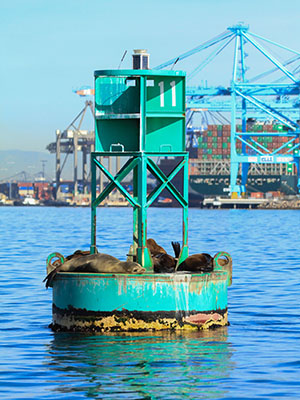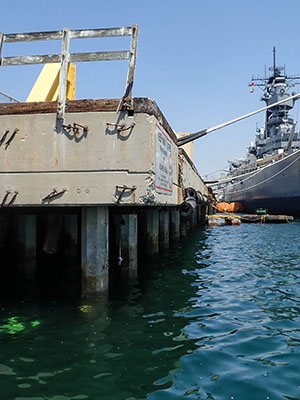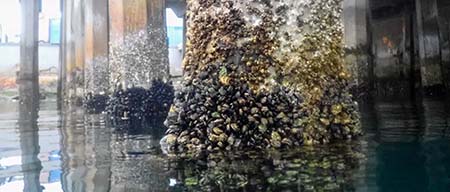
Cruise Ship Promenade and
San Pedro Waterfront

You Are Here
The waterfront near the Cruise Ship Promenade and the San Pedro Waterfront offers visitors a chance to walk along the water, observe the working container terminal across the main channel, relax and take in public art in the nearby parks, and visit the USS Iowa Battleship Museum and the Maritime Museum.
On this Page:

Habitats Located at
Cruise Ship Promenade and
San Pedro Waterfront
Located along the Main Channel in the transition from the outer harbor to the inner harbor, habitats near the
Cruise Ship Promenade and San Pedro Waterfront include muddy seafloor, pelagic habitat, and pilings.

Seafloor
The seafloor in the Main Channel is composed primarily of muddy sediments that slope upward underneath the large docks of the shipping terminals along the shoreline of the channel. Common animals here include barred sand bass, scorpionfish, crabs, and animals that burrow into the sediments such as worms and small clams.
Learn more!
Pelagic
The open-water pelagic zone is concentrated in the middle of the Main Channel, away from the shipping terminals and docks. Common animals here include anchovies, dolphins, sea lions, waterfowl, and seagulls.
Learn More
Pilings
Supporting the large marine terminals and the smaller docks, hundreds of pilings in the Main Channel provide hard substrate for animals to attach to or forage along. Animals like oysters, scallops and tunicates attach to pilings and filter food out of the water column while others such as sea stars, crabs and nudibranchs climb up the pilings looking for food.
Learn MoreWhat Lives Here?
Animals living in the Main Channel are most commonly found attached to pilings, relying on tidal currents to deliver food such as plankton and organic matter that can be filtered out of the water. Fish and large invertebrates feed on animals that have fallen to the seafloor after being dislodged from pilings, as well foraging for smaller invertebrates that live in the sediments. Check out the photos below to see examples of species that have been found near the Cruise Ship Promenade and San Pedro Waterfront.

Habitat: Riprap and Pilings. The Mediterranean mussel, Mytilus galloprovincialis, is a non-native species that has been introduced into coastal habitats worldwide both unintentionally through shipping and purposefully through aquaculture. Common and often abundant in intertidal habitats throughout the harbor, mussels feed by filtering plankton and organic material out of the water.

Habitat: Riprap and Pilings. There are two species of oysters common in the harbor, the native Olympia oyster (Ostrea lurida) and the non-native Pacific oyster (Crassotrea gigas; pictured). Olympia oysters grow to a size of only 2-3 inches and were about 20 times more abundant in the harbor than the non-native species, which is conspicuous when growing on pilings as it can reach sizes of 10 inches. Oysters feed by filtering plankton and organic material out of the water.
Pilings and Seafloor in the Main Channel
Check out some of the animals that live on the pilings and the surrounding seafloor in the main channel!
Test Your Knowledge!
How much do you know about
Intertidal Species?
Which species live in the upper tidal, lower tidal and subtidal zones?
Play our game to find out!
Drag the picture of the animal into the zone that it lives in.








